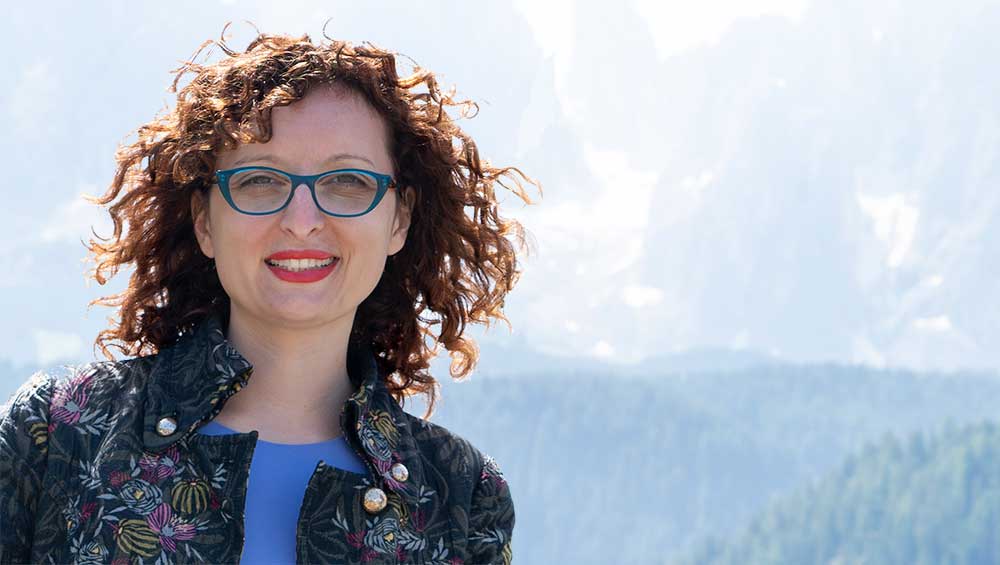
Lucia Pietroiusti. Photo: Thaddäus Salcher.
by VERONICA SIMPSON
I first encountered Lucia Pietroiusti, the Serpentine Galleries’ strategic consultant for ecology, at a panel discussion, called Can the Art World Be Sustainable? It was February 2020. The UK’s first lockdown was just around the corner, and although we had no idea of what was ahead of us, the escalating pandemic seemed to be lurking in the murky basement of the London Arts Club venue. It made the discussion, around how art and its institutions could better help us care for the planet, for each other and for all its species, seem all the more urgent. Of all the speakers at the event, Pietroiusti came across with the greatest lucidity – and optimism that huge, systemic change was not just desirable but possible. This clarity and drive are reflected in the rigour with which she has transformed the systems and perspectives of the Serpentine Galleries’ research, engagement, events and exhibition programmes, as founder and curator of the General Ecology Project, from 2018-21 and, before that, as curator of public programmes (from 2013).
While she states in this interview, “I’m definitely not an exhibitions curator”, her curatorial perspective is becoming increasingly visible and valued in the current research-rich, ecologically driven, artist-led international arts programme. That visibility was boosted when the eco-operetta Sun and Sea (Marina), an immersive, musical performance on an artificial beach, which she curated with the Lithuanian artists Rugilė Barždsiukaitė, Vaiva Grainytė and Lina Lapelytė, won the Golden Lion for Best National Participation at the Venice Biennale in 2019. It is now touring internationally, until 2024. She has also co-curated the Serpentine’s Back to Earth programme over the last two years, inviting artists to propose environmental campaigns, prototypes and interventions, which will see its culmination in an exhibition at the Serpentine in June 2022.
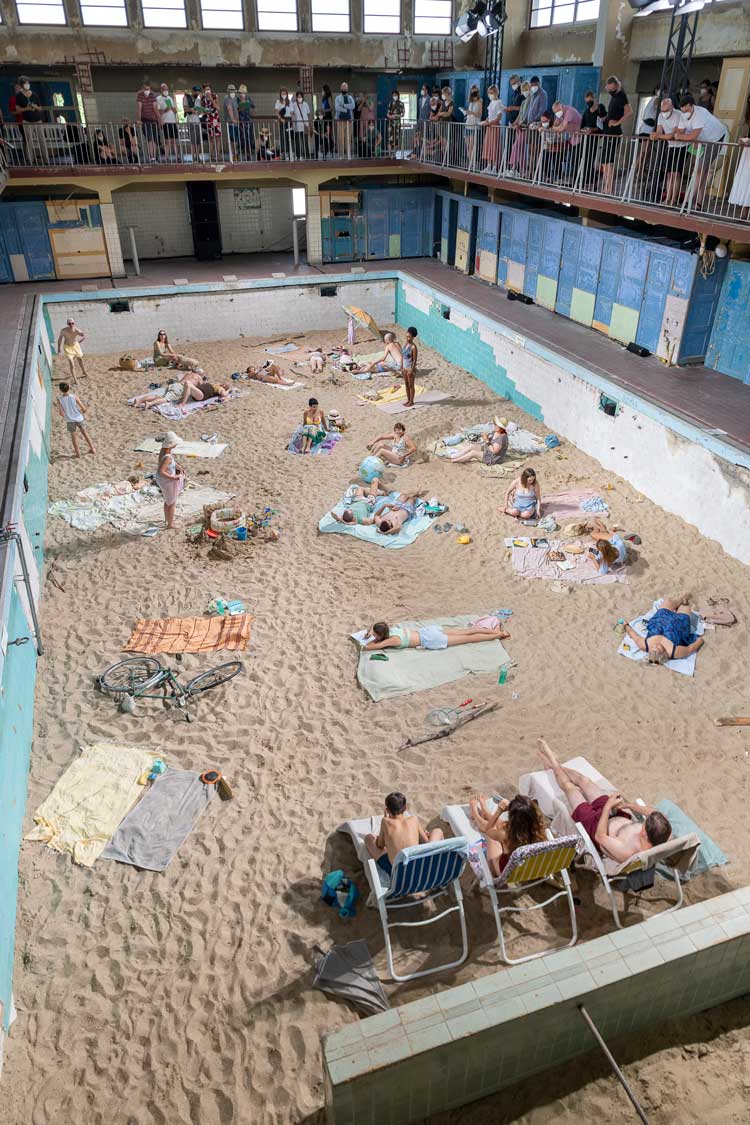
Sun and Sea (Marina), an eco-operetta curated by Lucia Pietroiusti with Lithuanian artists Rugile Barzdsiukaite, Vaiva Grainyte and Lina Lapelyte, for Venice Art Biennale 2019, being performed at E-Werk Luckenwalde in 2021, as part of Power Nights, curated by Lucia Pietroiusti.
The middle of this year will also see the blossoming of several of her other projects, from the concluding chapter of the nine-month Being Mothers programme at E-Werk Luckenwalde, Berlin, to the co-curation (together with Filipa Ramos) of the Eighth Biennale Gherdëina, in the Italian Dolomites, on the theme of Persons – investigating relationships and mythologies around mountains, plants and other “more than human” beings.
Pietroiusti has a BA in English and French literature (2002-05) and an MPhil in women and gender studies (2005-06), both from Trinity College Dublin, plus an MA in critical and cultural studies (2011-12) from Birkbeck, University of London. She is co-founder, with Ashish Ghadiali, of the climate-justice focused not-for-profit organisation Radical Ecology. She has co-edited and written books, including More-than-Human (with Andrés Jaque and Marina Otero Verzier, 2020), Microhabitable (with Fernando García Dory, 2020) and Plantsex for Mal Journal (2019). She was one of the curators of the 13th Shanghai Biennale (2020/21), with the theme Bodies of Water. Together with James Bridle, she will curate a section of the 2022 Helsinki Festival dedicated to artificial and more than human intelligences.
Veronica Simpson: How did your ecological approach to curating evolve?
Lucia Pietroiusti: I think it happened … in stages. I would place the marker in 2014. At the time I was working as curator of public programmes at the Serpentine, which was not just discursive conference events, but a robust programme of time-based commissions and performative interventions and discourse. It was part of the post-disciplinary area of activity at the Serpentine.
At the time, we were very close to Gustav Metzger, who was one of the people to be outspoken on the environment really early on. Partly because of his background - he was put on the Kinder transport at the age of six, having lost his parents in the Holocaust – his work was always to combat, or act against, or resist extinction. He had that concern always. There was a point after his solo show in 2009 at the Serpentine (Decades 1959-2009) where he started to spend a lot of time with us. And he always said that you need to do something to be part of actions against extinction. When it came to deciding what the subject matter of the yearly Marathon festival would be - we used to do these multidisciplinary festivals, like snapshots from the present of different disciplines around a theme, and as performative as possible – Hans Ulrich [Obrist, artistic director at the Serpentine Galleries] and I agreed we should co-curate it with Gustav and theme it around extinction. Marathon wasn’t environmentally focused as such, but I think in the way we programme, we both tend to think about the slippages of words - the extinction of languages, of places, of life forms. From that moment, for me, personally, the research was important. It felt very different from any other kind of thematic research endeavour. It was more from the gut than the head.
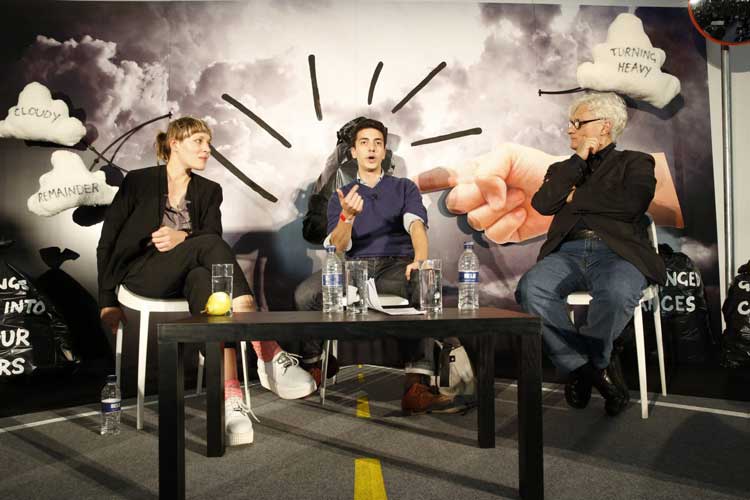
Panel discussion at Extinction Marathon: Visions of the Future, 18-19 October 2014 at Serpentine Galleries, London.
I remember having a conversation with Hans Ulrich when we came to programming the following year’s Marathon. I said maybe we should do the Marathon on extinction all the time. We didn’t end up doing that, but the trilogy of Marathons that took place from Extinction through to Transformation and Miracle, over the three years from 2014-2016, were continuing on similar avenues.
In 2015, this theme came up again when I did a symposium called An Evening on the Great Pacific Garbage Patch, which was responding to Pascale Marthine Tayou, and his use of recycled materials and rubbish from the oceans and his visions on planetary interconnection (it ran alongside his Serpentine show Boomerang).
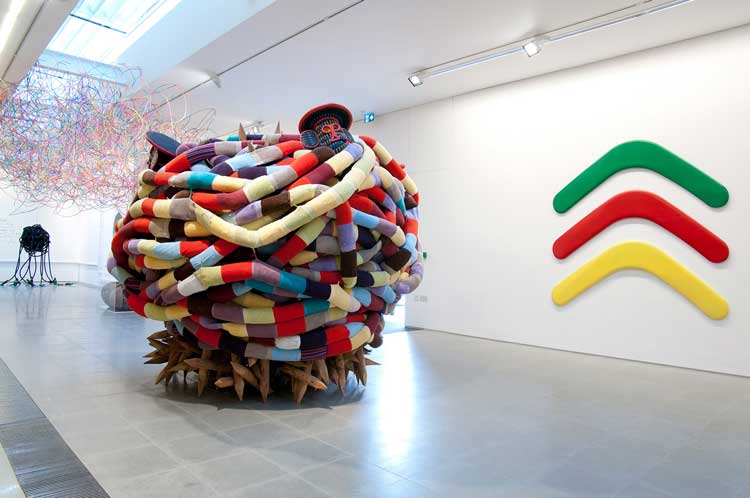
Installation view of Pascale Marthine Tayou’s show Boomerang (4 March – 17 May 2015) at Serpentine North Gallery, London. Photo: READS 2015.
Then I had a baby in 2017. And that experience was profound: you hear a lot of environmentalists who will tell you that having a baby awakened them to their responsibility towards future generations. I tend to hyper-intellectualise emotional experiences so, when I found myself with this little being, I was reflecting on a ton of stuff that was definitely more in the mind than in the gut – around, for example, communicating beyond language, where there is a relationship of care, obligation, responsibility with a “more than human being”, and language isn’t involved in that communication. It goes without saying that your care, obligation and responsibility towards more than human beings in general doesn’t need language to communicate or to care or have responsibility. It’s very much a [American philosopher and author] Donna Haraway kind of viewpoint: when you co-evolve with a more than human being and learn to know it on its own terms. So, that was “Thought Number One” from having a baby.
“Thought Number Two” was a little bit like intergenerational responsibility, but had a lot more to do with the perception that we have about time. All of a sudden, there was a sense of being able to perceive a time, literally through the love of one’s child, past the scale of one’s own life. Once you have de-scaled or un-scaled your perception of time, even just by 20 years or 30, however long they outlive you, then you’ve done that mental exercise. Which means undoing the scale of time further is a cognitive possibility. That led me down the path of “more than human” relationships on the one side, and de-anthropocentering questions around time and language and so on.
So, in 2018, on the back of that period of maternity, I wrote this project for the Serpentine, which was the General Ecology Project. The aim was to string together all the activities - logics, programmes, efforts, infrastructures - that had anything to do with the ecology in the environment but also systems, such as organisational ecologies, social ecologies, both within the organisation of the Serpentine as an institution and also in the network of organisations and institutions that the Serpentine belongs to. So, diversifying from a disciplinary standpoint the network of collaborators - expanding it to environmental charities, lawyers, scientists - while at the same time maintaining a discursive connection with the environment and practising the same strategy at the level of systems, skills sharing, resource sharing, resource reduction. That was the General Ecology Project in its infancy. We said: let’s start with auditing what it is that we’re doing all together … Then I proposed this role: curator of general ecology, not only because it sounded really cool, but also because I thought that if we created a role for it, and were making a de facto structural change, if you can make a small structural change then it proves the concept that you can make a large one.
VS: It now seems like a huge cultural shift has been achieved in what the Serpentine focuses on, who it addresses and engages with and how you operate. What intrigues me through all this is that you didn’t seem to stop to think – but is this art? That wasn’t the main question.
LP: On the one hand, the question “Is it art?” would not have occurred to me because my background is in research. My family background is in art but my research and study background are in literature, critical theory and general studies. The notion that I was there, in an art institution but doing things that were and were not art was kind of a default. The Serpentine is profoundly artist led, [it exists] to transmit through alternative ways of knowing certain things. It’s not a museum, which has a collection and a responsibility to display it. And in being artist led, it gave me and my curator colleagues a lot of licence in terms of inserting or embedding artistic mind processes into whatever it was that we were doing. In a sense, the question of whether it’s art becomes irrelevant. The other question, “Is it environmental action or environmental justice?”, becomes irrelevant because you’re talking about the meeting point of the two.
With hindsight, there was a lot more that landed for me about what is the artist’s role in environmental justice. I think we all start from the principle that the role of art in the environmental field is almost like public understanding and public dissemination. How do you make data powerful or beautiful or emotional or sensible? How do you make it visceral? What I realised was that, by working with lots of different artists - particularly through the Back to Earth project - on what they thought could be forms of environmental engagement, while maintaining their position or their world as artists, art can do a million other things. Anything from accelerating innovation through lateral thinking – it has a proven effect on the work of idea-making – to enriching public understanding, public dissemination. It also has these other side bits that I’ve become interested in when you think about systems. Sometimes, getting something through, getting it funded, making it real, as an artwork is paradoxically easier than it is as a farm project or community garden project, because the field is not as saturated; what is necessary, what is new, wanted or needed is different in different fields.
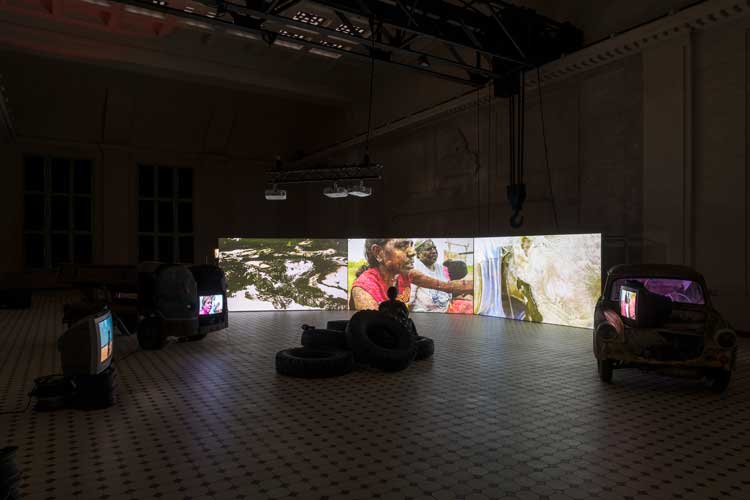
Installation view of The Family (A Zombie Movie) by Karrabing Film Collective, as part of Power Nights curated by Lucia Pietroiusti at E-Werk Luckenwalde, 2021–22. Courtesy: E-WERK Luckenwalde and Karrabing Film Collective. Photo: Stefan Kort.
If you think about how to find the path of least resistance to achieve something, the example of the Karrabing Film Collective [a grassroots Indigenous-based media group] is one that I love, as a collective that works really in place and on issues around late-century colonialism. They exist in the art world through the economy of film commissions, and they make incredibly beautiful and powerful films. But that economy in turn makes possible… the kind of subsistence funding of the kinds of work that they’re doing on the land, around mapping ancestral totems and dreaming … and working on community projects and passing on that knowledge to the younger generation. An art institution wouldn’t be able to directly fund that. If you went into the NGO and social justice base [for funding], it’s quite saturated already. If you have this third possibility, which is the artwork in the middle, then the artwork becomes a catalyst towards a larger movement.
VS: Tell me about the Back to Earth programme.
LP: That’s another Serpentine project, which was conceived to mark the 50th anniversary of the Serpentine, which happened in 2020, but the advantage (of the pandemic delaying it) … was that it pushed the project to go beyond the exhibition format. The Back to Earth exhibition is happening this summer. But we have been working for two years on projects that happened online. The initial invitation was to 50 artists to propose something that was both an artwork and an environmental campaign. I’m sure we all thought that we’d just receive 50 posters that would say things like, “Don’t buy plastic”, “Don’t fly”, campaigns in the narrowest sense of the term. But what we got was an artist working on just and fair transitions in Colombia, an artist developing a centre for the resistance of non-western hegemonic wisdom around land and ecology in French Guyana, and an artist developing a curriculum around forest management. We got a lot more than we could have imagined, ever. Again, being artist led, the artists were the ones who taught us what the possibility of the institution could be, in terms of what it could get involved in.
VS: The Formafantasma show, Cambio, in 2020, was part of that initial Back to Earth year of programming you had planned? It was a great show.
LP: Cambio was so good; it was curated by Rebecca Lewin, my colleague in the Back to Earth programme. I was involved at the beginning, because there was so much around plants and it was around the time Filipa Ramos and I were curating The Shape of a Circle in the Mind of a Fish project and the other symposium for Plant Sex, which is so dear to me – Plant Sex 2 is coming. We did a lot of knowledge exchange with Rebecca and Formafantasma, and we learned a lot from them, and they from us, but they went much further in the research, like the politics and economics of timber, it was absolutely brilliant, I agree.
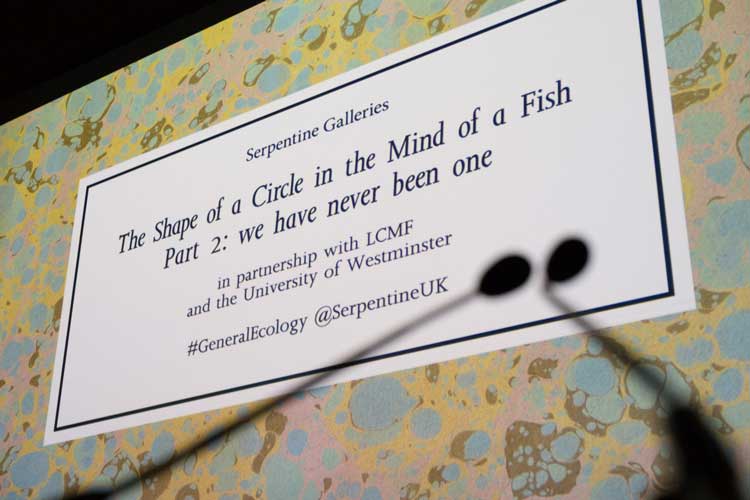
Shape of a Circle poster, from 2017 event.
VS: The Back to Earth exhibition is finally about to open this summer. Meanwhile, last year, you launched the Being Mothers programme at E-Werk Luckenwald, a former power station outside Berlin, with a show that unveils itself in stages over nine months. It’s a great example of slow curation.
LP: We started that arguably in July 2021 with the presentation of Sun and Sea (the Venice Golden Lion-winning environmental operetta) in Berlin. The initial invitation from E-Werk was to curate the second edition of Power Night. In its first shape, Power Night was a day and evening of performances. And it was planned for September 2020. And already, as we were thinking through it, a lot of the artists that I had wanted to work with were leaning into longer lasting things, things that felt more like installations. When Covid hit, I think we moved the date a couple of times. But because of the extraordinary flexibility that E-Werk has – because it’s a new institution, it can do lots of things other institutions can’t – we wondered what it would be like if we slowly opened one piece at a time? I’m definitely not an exhibitions curator, but somehow the conversations with every artist just landed on something that felt more like an offering that could be longer lasting. We thought, OK, let’s open them one at a time, whatever’s ready, whenever it’s ready, in the right space and in the right context.
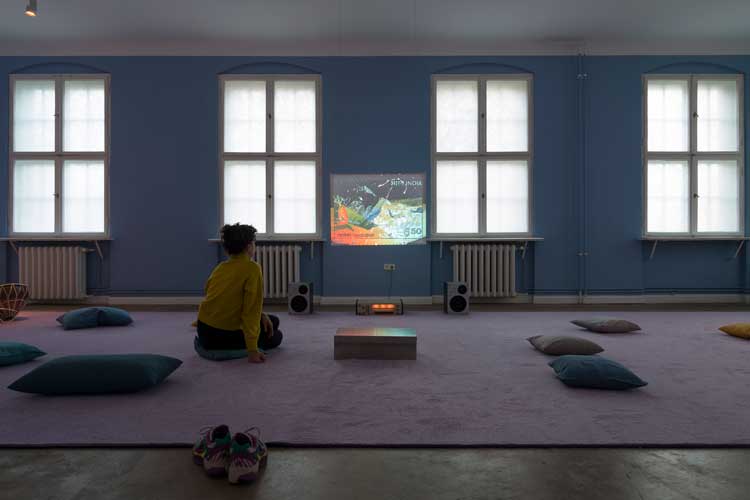
Installation view of Static Range by Himali Singh Soin, as part of Power Nights curated by Lucia Pietroiusti at E-Werk Luckenwalde, 2021–22. Courtesy: E-WERK Luckenwalde and Himali Singh Soin. Photo: Stefan Korte.
It started with Static Range by Himali Singh Soin and Karrabing Film Collective’s The Family (A Zombie Movie). Both of those were co-commissions between the Serpentine and E-Werk. And that was another example (of ecological thinking): that if you’re wearing different hats with different organisations, then you can pool resources that benefit people by virtue of the fact of you happening to be a link between them. But with Himali, the piece Static Range coincided with the planting of a radial garden outside in the E-Werk grounds. They did a soil analysis of soil from coal, because it was a power station, then planted a garden that would clean up that toxicity. You have something that looks like a show indoors, but you also have this embedded work outside. Similarly, [the London-based duo] Cooking Sections have developed a recipe for bread for the restaurant at E-Werk, so that will remain, almost as part of a permanent collection at an institution that doesn’t have a collection. They have been working with local experts on ancient grains and local baking techniques. Then, finally, the Power Night in the shape that it’s supposed to be in, in the first place, opened at the end of April.
There’s a kind of coincidental serendipity in the fact that this whole project unfolded almost over nine months, and it’s inspired by the notion of mothering, but less the kind of essentialist notion of femaleness and femininity, but more as a way of thinking through the slippages in the imagination - mothering, Mother Earth, environmental care, but also fertility, fertilisation, infertility, toxicity of the land causing infertility in humans. If you just let loose those concepts, and allow them to spill slightly like olive oil, then they kind of lead you places and allow you to understand the interconnection between the more than human world, the political worlds, the human and social justice worlds. All these things we experience through disciplinary boundaries, that we experience as separate, are in fact not. You can start from soil, or you can start from mothers or weather or air or water. It’s a recurring thing. The Shanghai Biennale was called Bodies of Water as a way of thinking about bodies and queerness and rivers.
VS: Given your advocacy of better planetary and species stewardship, do you feel the art world is holding itself to account in any way, watching its carbon footprint or evolving its practices?
LP: On a collective level, I don’t doubt that it has. Something really substantial happened between 2019 and 2020. On the one hand, Covid hit, and institutions that are dependent on footfall and commerce struggled a lot more than those that had offsite and online and post-disciplinary kinds of endeavours. And on the other, there was the kind of environmental awakening of the art world in 2019. It was fortunate in terms of timing, given the success of Sun and Sea at the Venice Biennale, but it felt like it was there and ready for when that door opened. Then the more civic coming to consciousness around questions of antiracism, all those things offered avenues for institutions, museums in particular, to slightly change things. And I’ve seen countless transformations happening from the outside. But also, I’ve spoken with so many more curators that have some kind of environmental remit. Obviously, it remains to be seen whether these are long-lasting changes or whether they are temporary.
I am a relative optimist when it comes to institutional transformation. I think that they can and do transform. What I am a little concerned with in the environmental space is the sort of… solutionism that exists in the sort of net zero discourse, as both governments, and therefore institutions and museums, take this notion of net zero as the answer, and, unfortunately, you can’t separate the issues of the amount of carbon in the atmosphere from questions of inequality, and both human and more than human displacement. From the point of view of what an art organisation can do or commit to, I’m constantly asked to talk about sustainability in the gallery and I’m the person who knows the least about packaging and shipping, but I hesitate, I always hesitate to speak of it without speaking of larger pictures, even ones that we feel that we have no control over, like the art field. Because net zero science is based on incomplete science.
There’s a great effort that the art sector and industry in general has made towards greening and sustainability. But rather than reducing harm, can we work towards the possibility of leaving things better, with environmental justice and balance at heart.
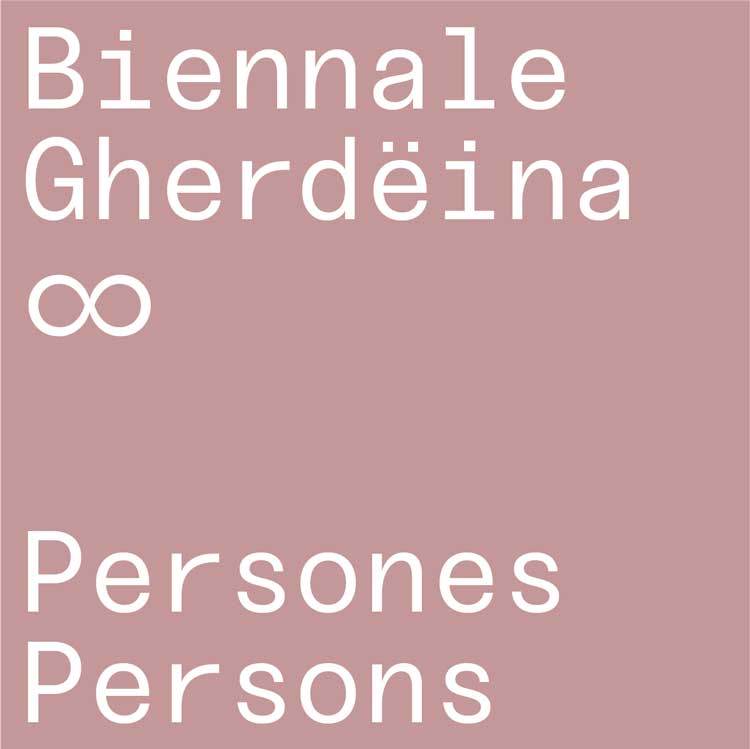
Poster for Biennale Gherdëina, curated by Lucia Pietroiusti and Filipa Ramos, which takes place in the Dolomites, Italy, 20 May – 25 September 2022.
VS: Which brings us to the Biennale Gherdëina, a festival you are co-curating this year, with a theme that celebrates our relationship with nature and more than human beings.
LP: This is a relatively small-scale biennale, around 20 artistic practices. It happens at the foothills of the Dolomite mountains, which are rich with mythology. Again, it’s a collaborative endeavour, with Filipa Ramos, with whom we did the Shape of a Circle project. We are taking some of the learnings from the Shape of a Circle and its insistence on a kind of non-anthropocentric idea … we decided to call the biennale Persons as a way of thinking through the vitality of human and more than human beings. There’s an element in (the work) that leans on the legal notion of personhood, and there’s an element that has to do with landscape and beings continuously shaping one another, which was very important to Filipa. Particularly, as she looked at the practice of transhumance, the [seasonal] movement of humans and animals up and down hill. And so how much are we persons? How much are we environment and landscape? How much is landscape person? These are the questions we proposed to ourselves, but also the artists. There are some playful elements to it. Gherdëina has a rich history of wood carving and toy making.
Then there are other readings of the theme, ones that are more spiritual, ones that are more about knowledge production. There is a mothering element. There are beautiful stories from the region that haven’t been translated that we’re looking to translate. One of the other things that’s been so important in the last two years, for both Filipa and me, is how myth is a way of holding knowledge across generations and across time. These mythologies and these more than human relationships that exist in stories are almost like memory palaces of what we collectively, as a species, build knowledge around. And that knowledge, more often than not, has to do with where we come from - agriculture, how plants and animals relate to each other - and weather. Those are what myths are usually about. And we tend to think of these (relationships) as a science almost, as technology. And to a certain extent art is a form of myth-making, so to think of art as a kind of science or technology, a knowledge keeper, is really fundamental to the concept of the show.
• Power Nights: Being Mothers is at E-Werk Luckenwalde until 31 July 2022.
Sun and Sea is at The Albany, Deptford, from 23 June to 10 July 2022.
Back to Earth is at the Serpentine Galleries, London, from 22 June to 18 September 2022.
Persones Persons, the Eighth Biennale Gherdëina, runs from 20 May to 25 September 2022.